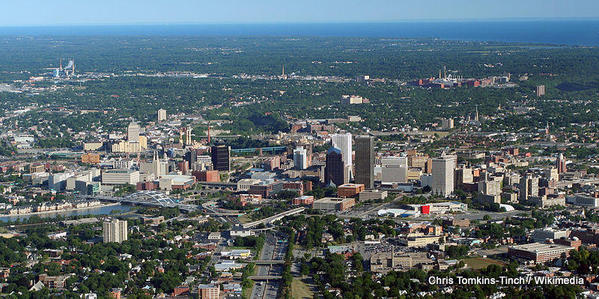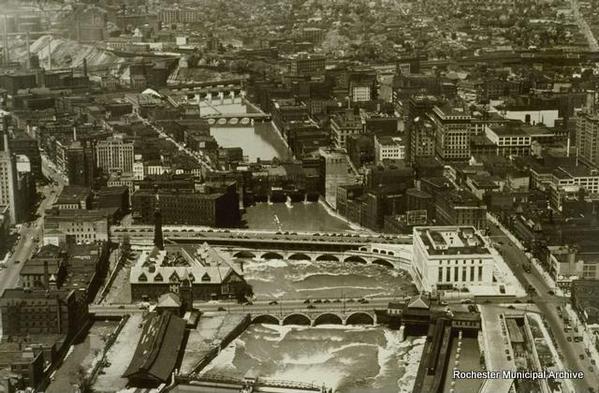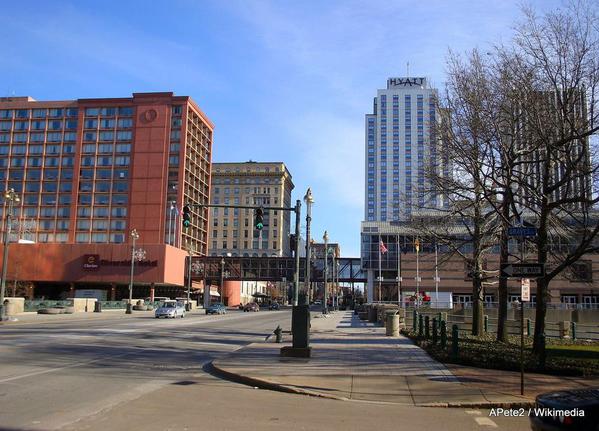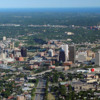Gumbo’s location in Puzzle #140, as Travelling Canuck and GarryRF recognized, was the puzzling city of Rochester, New York—a city that has re-invented itself so many times that its nicknames tangle the tongue. It’s been the Young Lion of the West, Flour City, Flower City, Image City, Little Detroit, Snapshot City and, tellingly, the Little Big City.
Clue No. 5 was this Chase Bank building, one of the new downtown anchors
Rochester today feels much more like a big city than most cities its size, perhaps because of its long history, and perhaps because of the important industries which started there, and still, in one form or another, live there: Kodak, Bausch & Lomb and Xerox, just to name the best-known. Not to mention, if you’re driving a GM car, Rochester is the name on most of the fuel line and injector parts in your car.
Xerox lives just down the street from Chase in this dark-toned building
So, unlike so many older northern mid-sized cities, Rochester has refused to die, and is actually growing. Once a distant third to Buffalo among the state’s cities, Rochester and its metro area may slide into second by the next census. The downtown cluster of historic and new skyscrapers, some still under construction, marks the area where Gumbo was, while visiting a state science teacher conference hosted annually in Rochester’s convention center.
Here you see the Canal crossing the river and turning parallel to it, approaching the Lehigh station, which you'll see further on in this blog. This image is from sometime between 1905 and 1919. In the 1930 scene below, the Central Library building sits on the former canal site, and subway tracks run beneath it in the canal bed. The Lehigh (right) and Erie Lackawanna (left) railway stations face each other across the river.
Rochester’s first fame, and the source of two of its nicknames, came in the 1820s with the Erie Canal, which ran through the center of the city until it was re-routed in 1919. The canal brought wheat and other grains from western New York and even cities across the Great Lakes to Rochester, where it was milled into flour (hence that name) before shipment to New York City and Europe. That also gave rise to its fame as the Young Lion of the West.
The bridge (above) seen in the first clue of the puzzle (and also in the fourth) was originally the aqueduct that carried the Canal across the Genesee River. The lower level was the canal; after the canal was moved, Rochester laid subway tracks along the old canal route, and added the upper level as a road bridge to carry Broad Street across the river as well. Both helped relieve what had become impossible downtown traffic. The subway was shut down in 1956 in favor of highways; this is what the inside of the aqueduct looks like now.
But perhaps Rochester’s greatest fame is connected to the millions of small yellow boxes that meant “film” all over the world. Rochester was the home of George Eastman, who marketed the world’s first successful line of amateur cameras and film, and then built Eastman Kodak into a “go-to” for all kinds of photography.
That business is largely gone, now, but Kodak remains as a somewhat smaller but key company in graphic arts, commercial printing, packaging and medical technologies, and research.
George Eastman's home, now Eastman House, the first and one of the foremost photography museums
Xerox, another imaging company that once completely dominated its industry but now plays a different role, is also a Rochester native. Bausch and Lomb is the oldest of the Rochester giants, founded in 1853. Its global headquarters moved to New Jersey last year, but it still has a large presence, and a new office building in Rochester.
Rochester's annual lilac festival
When the railroads arrived, Rochester became an important rail center, and while the flour-milling business moved on to mills in the Midwest, Rochester’s all-weather rail service to east and west allowed it to become the center of the fruit and ornamental plant nursery business in the U.S. from the 1850s to the 1890s—hence the Flower City nickname, which lives on in an annual lilac festival. By the time the nursery business was winding down, Rochester had entered its Kodak moment.
And Rochester is a culinary center, noted for its signature invention: the Garbage Plate. Originally made at Nick Tahou’s restaurant (and the name is trademarked but no one pays attention), it defies description by anyone (me included) who hasn’t had the guts to try one. So I’ll leave that to RocWiki, the People’s Guide to Rochester:
A Garbage Plate is a true Rochester delicacy. It is a disorganized combination of either cheeseburger, hamburger, Italian sausages, steak, chicken, white or red hots, a grilled cheese sandwich, fried fish, or eggs, served on top of one or two of the following: home fries, fries, beans, and mac salad. A plate is always made to order. Then, the plate is adorned with optional mustard, onions and Rochester's version of hot sauce. Some restaurants will charge for extra helpings of hot sauce, and the hot sauce varies widely in flavor and spiciness. A plate is usually served with a side of white bread and butter, though some restaurants charge extra for bread. It is said that the purpose of the bread is to soak up the grease left after you've eaten the garbage plate.
Abbott's Frozen Custard (yes!) restaurant in the Warner Lofts building has both a breakfast garbage plate and a dinner garbage plate. Next time, I'll try to be brave...this time I settled for really good Frozen Custard. The building is seven stories of stone pillars and cast-iron walls; it's recently been renovated into pricey apartments.
After a spate in the 1970s and 1980s of removing old buildings, Rochester has gotten good at re-use. Near the Warner Lofts (which were originally the laboratory, factory and business offices for "Warner's Safe Cure," probably best described as "snake oil), is the 1897 Sibley Building, empty for several years, and now becoming a mixed retail/office/ residential building. With its tower and taller eastern section, it's a local landmark, as is its neighbor just off Main Street, this wonderful facade that belonged originally to the Rochester Savings Bank.
Besides Eastman House, the city has a number of other cultural and education features, including the Eastman School of Music, a leading conservatory; the University of Rochester; Rochester Institute of Technology; theater programs, a symphony orchestra and a truly unusual museum, The Strong, which subtitles itself the National Museum of Play. That's a fun story for another Gumbo moment soon; for now, here's a picture.
I spent most of the breaks from the science conference wandering the area to get a feel of the city. While downtown is pretty empty on weekends, it never felt deserted, and on Monday there were actual traffic problems. Here are some of the sights from my wanderings...starting with the Central Library building, which sits over the former canal and subway route. In fact, in the lower picture, it still spills water from canal and mill raceways into the river.
A block down from the Library, at Court Street, I visited the old Lehigh Valley freight station for lunch. Its railroad days are long over, but it's occupied by a branch of the Dinosaur Barbecue chain and does a brisk business. The Lehigh's competitor was at the opposite side of the Court Street bridge, but is now gone, replaced by a leafy walk.
Walking away from the river at Court Street, I came on this Civil War memorial in Washington Park, a block-square park surrounded by Xerox, Bausch&Lomb (2nd picture) and two interesting churches.
Facing the park on one side is the 1834 St. Mary's, a Catholic church; on another corner is the First Universalist Church.
The Civil War memorial isn't Rochester's only interesting public sculpture. One of the easiest-to-spot downtown landmarks is this monumental sculpture atop what is now called the Times Square Building but was originally the Genesee Savings Bank. It's called Wings of Progress, and each wing weighs over six tons. Ironically, the cornerstone for the bank was laid on October 29, 1929—the date of the Black Friday stock market crash.
Mercury has a home in Rochester, too. Originally he stood on the smokestack of the Kimball Tobacco Factory along the river, but after 23 years of storage after the factory was demolished, he found a new home on the Lawyers Cooperative Publishing Co. building. It's the work of Guernsey Mitchell, then a well-known sculptor, and the brother-in-law of the factory owner. At the time, it was the largest bronze statue in the United States.
And the tradition continues in a modern way with this piece by Albert Paley, called Genesee Passage. It's near Washington Park in front of a new building. You're free to guess what it signifies, but we're not offering any prizes!
Below, another of Rochester's 19th-century "piles," a charming pastiche of styles and materials. Possibly subject to severe architectural criticism, but l found it charming.
And, at the bottom, a look across Main Street toward two of the major hotels and the Convention Center...and a piece of the Skyway, an intercon-nected series of pedestrian bridges and tunnels that connect a dozen or more major buildings...and for a city with cold winters, that's a plus.
If you’re planning to visit: the main downtown hotels near the Convention Center are pricy, but there’s a good assortment of reasonably-priced hotels and motels along the roads in, within a 10-15 ride to the center. We met people who reported they found a good variety of Airbnb locations, including downtown.
There’s lots of parking in the center area’s garages for about $6-10 a day. And on weekends, the downtown streets are so empty you can stand in the middle of the road to get a good angle for a picture!
Aside from Abbott's and Dinosaur Barbecue, mentioned above, we enjoyed meals at
- James Brown's Place, at 1356 Culver Avenue. It's not just a breakfast place, but that's what it's famous for. There are nearly 20 kinds of breakfast sandwiches, and that's only part of the menu. Prices reasonable, and lots of locals.
- Sinbad's Mediterranean Cuisine, at 719 Park Avenue, on an up-and-coming strip with lots of interesting looking restaurants. Highlights included a wonderful chicken vegetable soup that was really "lots of vegetable soup with chicken, too," kebbe and really good hummus. On Saturday night, you might have to wait a while.







Comments (4)